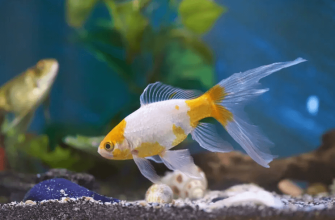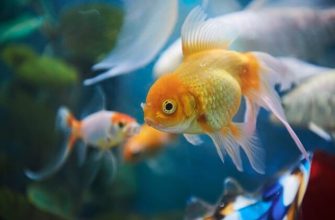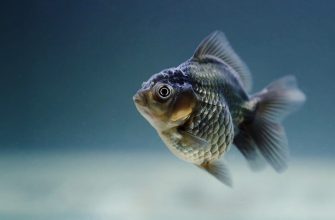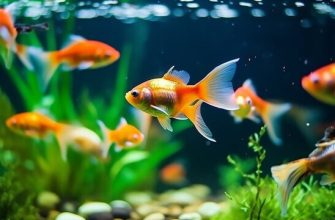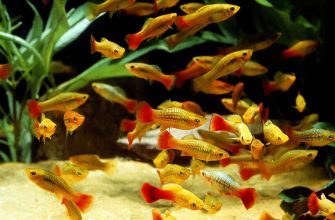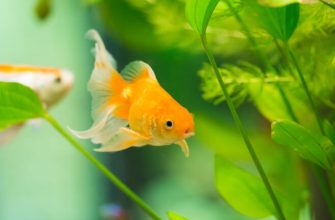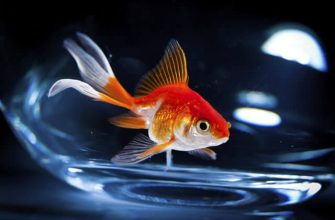Goldfish, with their vibrant colors and graceful movements, captivate the hearts of aquarium enthusiasts worldwide. As caretakers, it’s natural to wonder whether our aquatic companions experience loneliness. If you’ve ever pondered, “Do goldfish get lonely?” you’re not alone.
In this guide, we’ll delve into the fascinating world of goldfish social behavior, exploring whether these beloved aquatic creatures truly experience loneliness and how we can ensure their well-being in our care.
Do Fish Have Emotions?

There has been much debate over whether fish experience emotions beyond basic feelings like fear and stress. Studies have shown that fish do react to painful stimuli, indicating they feel pain. Zebrafish have been observed exhibiting signs of anxiety and antisocial behavior when exposed to alarm substances, suggesting they experience fear and stress.
However, the extent to which fish experience complex emotions is still up for debate. Some experts argue that fish lack the neural complexity for emotions like love, grief and anger. Their brains are simply too small and primitive compared to mammals. But other scientists point out that fish display interesting behaviors that could indicate deeper emotions. For example, cleaner wrasse fish appear to “cheat” their clients by feeding on mucus instead of parasites. This suggests an ability to anticipate how others might judge them, implying complex cognition.
Overall, experts agree fish can feel pain, fear and stress. But the jury is still out on whether they experience higher-order emotions akin to mammals. More research is needed to understand the inner lives of fish.
Social Nature of Goldfish
Goldfish are actually quite social fish that prefer to live in groups. They are schooling fish by nature and evolved to live together in ponds and rivers. Housing goldfish together provides many benefits for their wellbeing.
Goldfish that are kept alone can become stressed and skittish. They may hide more and exhibit signs of aggression or fear when humans approach. Keeping goldfish in groups allows them to shoal together which is comforting and mimics their natural environment. The presence of other fish provides enrichment through social interaction. Goldfish kept together will be more active as they swim and explore together.
Overall, the social nature of goldfish means they are best kept in groups to reduce stress. Goldfish kept alone risk becoming distressed without the comfort of companions. Housing goldfish together allows them to shoal, interact, and behave more naturally.
Enriching Environments for Goldfish
Providing an enriching environment is crucial for goldfish health and wellbeing. Goldfish require ample space to swim and explore. The recommended minimum tank size for fancy goldfish is 20 gallons for the first fish, plus an additional 10 gallons per additional fish. Single-tail goldfish require even more room.
Goldfish benefit from hiding spots, plants, and tank decorations that allow them to engage in natural behaviors. Live plants can provide enrichment, but plastic plants are safer since goldfish may eat live plants. Providing rocks, driftwood, and aquarium-safe decor creates a complex environment for goldfish to interact with.
Varied feeding methods also enrich goldfish. Floating and sinking foods engage their natural foraging instincts. Hand-feeding allows interaction with their owners. Food puzzles and treat balls provide cognitive stimulation. An enriched tank keeps goldfish active and engaged with their surroundings.
Goldfish Memory and Cognition
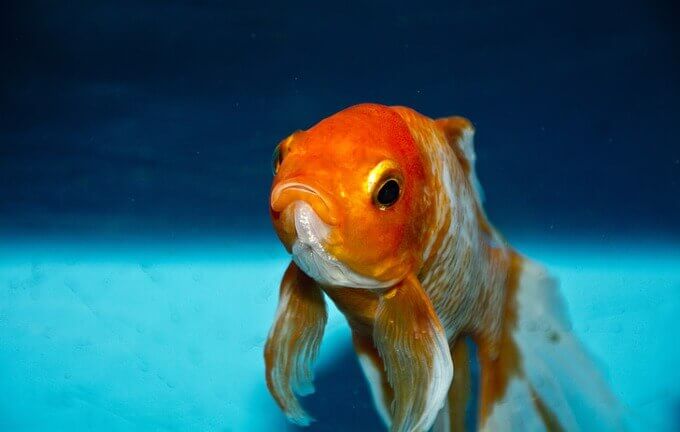
Goldfish have long had a reputation for having poor memories, with the phrase “3-second memory” commonly used to describe them. However, research has shown that this is a myth and that goldfish actually have good memories when compared to other fish species.
Studies have demonstrated that goldfish are capable of learning tricks and that they can be trained through positive reinforcement to associate certain behaviors with food rewards. Goldfish have been trained to push a lever to receive food, play soccer, and do other simple tasks. Their memory for these learned behaviors can last for months.
Goldfish are also able to distinguish between different shapes, colors, and sounds. They can recognize their owners and get excited when it’s feeding time. Their cognitive abilities are more complex than many people assume. While goldfish may not be as intelligent as dogs, cats, or other mammals, they are capable of basic learning and have good recognition memory. Their intelligence has been underestimated.
Signs of Distress in Goldfish
Goldfish exhibit clear signs of distress when they are stressed or unhealthy.
Some of the most common signs of distress in goldfish include:
-
Changes in behavior and appearance. Stressed goldfish may become lethargic and withdraw to the bottom of the tank. They may stop eating and lose their appetite. Goldfish may also start swimming erratically or floating vertically when distressed.
-
Discoloration and clamped fins. Unhealthy goldfish can develop faded, pale colors. Their fins may appear clamped and held close to the body rather than spread out. This is a sign of stress or disease.
-
Gasping at the surface. If water conditions are poor and oxygen levels drop, goldfish will gasp at the surface to get more air. This is a critical sign of distress.
-
Bloating or swelling. Bacterial infections, parasites, or constipation can cause goldfish to bloat or swell up. This is an unhealthy sign that requires treatment.
-
White spots or velvet-like film. These can indicate parasitic infections like ich, which are more likely to occur when fish are stressed or immunocompromised.
Paying attention to goldfish behavior and appearance provides important clues about their health and wellbeing. Changes like reduced appetite, lethargy, and abnormal swimming are clear signs something is wrong and the fish are under stress. Quick action is needed to diagnose and address the underlying issue.
Impact of Isolation on Goldfish
Goldfish are social creatures that prefer to live in groups. Solitary housing has been shown to cause significant stress and harm in goldfish. According to a study published in Behavioural Brain Research, goldfish subjected to isolation and crowding stress showed increased cortisol levels and suppressed immune function compared to controls. Cortisol is known as the “stress hormone” and prolonged elevated levels can lead to chronic stress and weakened disease resistance.
Another indicator of distress in isolated goldfish is sluggish and lethargic swimming. Goldfish evolved to live in large social groups, so a lack of companionship deprives them of normal species interaction. Just one goldfish alone in a tank or pond is not sufficient to meet their social needs.
While they may not experience loneliness in the same complex way as humans, the documented physiological effects show that solitary housing takes a significant toll on goldfish health and wellbeing. Providing an enriched environment with plants, rocks and proper tank mates can help alleviate some of the stress. However, the most impactful measure is simply keeping goldfish together in appropriately sized groups.
Providing Companionship for Goldfish
Goldfish are social animals that prefer to live in groups. Having other goldfish companions in the tank provides stimulation and interaction that prevents boredom and distress. The best tank mates for goldfish are other fancy goldfish varieties like fantails, orandas, black moors, and ranchus. These slow-moving fancy goldfish compatriots match the activity level and temperament of other goldfish.
Adding a few similar-sized goldfish to the tank allows them to shoal together, which is their natural social behavior. The companionship enriches their environment and supports their social needs. With other goldfish to interact with, they are less likely to get bored or lonely.
Meeting Goldfish Social Needs
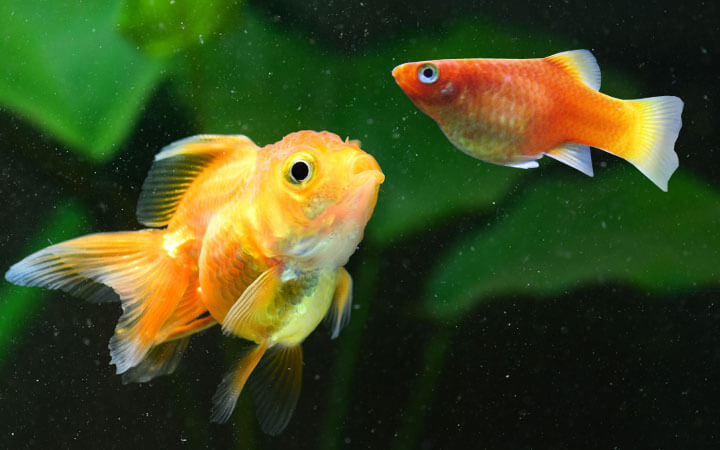
Goldfish are social by nature and can experience stress when kept alone for extended periods of time.
There are several key factors owners should consider to reduce solitary stress in their goldfish:
-
Tank Size: Goldfish require large tanks to thrive. The general recommendation is 20-30 gallons for the first fancy goldfish, plus an additional 10-20 gallons per additional fancy goldfish. Large aquariums provide more enrichment and space to reduce conflict when adding new tankmates.
-
Enrichment: Providing plants, rocks, driftwood and other tank decor creates a stimulating environment. Rearranging decor periodically also prevents boredom. Target training fish during feeding can provide mental enrichment.
-
Companions: Adding compatible tankmates provides social interaction, reducing solitary stress. Fancy varieties like orandas, black moors and fantails often appreciate having others of their own kind. Ensure new fish are quarantined and acclimated slowly to avoid fighting.
-
Signs of Stress: Owners should watch for clues like loss of appetite, increased hiding, frayed fins, rapid gilling and bottom-sitting. These signal excessive stress requiring intervention such as more enrichment or companions. A chronically stressed solitary goldfish may fail to thrive long-term.
Providing an appropriately sized and enriched habitat with same-species companions can help meet goldfish social needs and prevent the negative impacts of isolation. Careful observation enables catching problems early.
Conclusion
Goldfish are often seen as simple pets, but they have surprisingly complex social and cognitive abilities. While they may not experience loneliness in precisely the same way humans do, there is evidence that prolonged isolation and lack of stimulation can cause distress and harm their well-being.
Some key points:
-
Goldfish are social creatures that prefer to be in groups. Keeping them alone or in cramped conditions prevents natural shoaling behavior.
-
Providing an enriched environment with places to hide, plants, and tankmates can help satisfy a goldfish’s needs for companionship and mental stimulation.
-
Signs of loneliness in goldfish can include lack of activity, loss of appetite, and repetitive behaviors. Check for these if housing a single goldfish.
-
Consider getting at least two goldfish, or adding peaceful tankmates like snails, shrimp, or cory catfish to provide company.
The takeaway for goldfish owners is to not underestimate their needs. While we may never fully understand a goldfish’s subjective experience, caring for their social and psychological welfare leads to happier, healthier pets. With proper space, enrichment, and companions, even simple goldfish can thrive.


